
There are so many different types of systems out there today when it comes to stucco and the hardest part is actually identifying which system your house is using.
There are a few tips and tricks to the process that can help you along the way. Simple, yet very specific characteristics can answer the question. Let's break it down into something that is easier to digest, though.
What About The Weep Screed?
Another good way to tell what kind of stucco is installed on your house would be to measure the weep screed. Take a tape measure and measure the depth of the wall. Just butt your tape measure into the foundation and measure out to the edge of the finished stucco.
***Keep in mind that your measurement will include the plywood or OSB underneath the lath of the stucco.
- A Three Coat System is 7/8 of an inch, so 7/8″ + siding= about 1 and 1/4″ – 1 and 3/4 of an inch, depending on how thick your siding is (typically 3/8 of an inch for stucco).
- A One Coat System uses 1 inch of foam and 3/8 – 1/2″ of cement, so the total depth would be somewhere around 2″ (including the plywood underneath the lath).
- An EIFS System can vary in depth, depending on the thickness of the insulating board, if a particular manufacturer’s system was used, etc. The best way would be to break a small spot in the stucco and look at the layers.
If you have a look at the underside of the weep screed, you will notice many drain holes where water can escape. Try to shine a light up into the holes (if possible) and see what you can see. There will either be foam or cement. The foam indicates either EIFS or a One Coat System and the cement would indicate a Three Coat System.
There are three main stucco systems and they are: the three coat system, the one coat system and an EIFS system. This will be the starting point and will make the determination that much easier. Lets get started!
Try Knocking On The Wall…
Try knocking on the wall with your knuckle, or a softer object if your finish happens to be on the rough side. A wooden hammer handle works well for this technique. There will be two outcomes: a hollow type of a sound and one that is more solid.
One coat and EIFS Systems only have about 3/8 to 1/2 inch of “mud” on the wall, which is half of the amount used in a three coat system.
If your house is done in a three coat system, then it will sound a lot more solid. The EIFS System uses much softer materials than hard coat stucco and is a dead giveaway, in most cases.
Helpful Tip: Tap on the concrete foundation of the house to get familiar with what a solid thump actually sounds like. The foundation is the strongest part of a house, so it will be a good starting point for your ear.
The Best Methods:
The absolute best way to see what type of system your house has would be to break into a spot somewhere in the wall. This will eliminate any guessing you may have to do and will allow you to see what the various layers look like.
If you have an existing area that you plan on fixing anyways, then knock a small area around it out to see what is underneath. Your repair will only get a little bit larger and will not damage the stucco in the process.
If all else fails, then the best thing to do would be to hire someone who is familiar with stucco. They will have a much better understanding of what to look for and can usually determine what system is being used in a matter of minutes.

